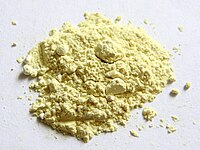
Photo from wikipedia
Abstract An efficient method for extracting bismuth (Bi3+) from a hydrochloric acid (HCl) system by cementation with copper (Cu0) powder was proposed in this work. The thermodynamic properties of cementation… Click to show full abstract
Abstract An efficient method for extracting bismuth (Bi3+) from a hydrochloric acid (HCl) system by cementation with copper (Cu0) powder was proposed in this work. The thermodynamic properties of cementation were investigated via cyclic voltammetry measurement and thermodynamic calculation. Then, the effects of reaction temperature, Cu0/Bi3+ molar ratio, stirring rate, HCl concentration, and competing ions on the cementation efficiency of bismuth were systematically investigated. Results showed that the cementation reaction between bismuth and copper powder was thermodynamically spontaneous. A Bi recovery of 99% could be achieved with copper powder under an optimized cementation condition (6 mol L−1 HCl, 60 °C, Cu0/Bi3+ molar ratio of 4, stirring rate of 500 rpm, and reaction time of 30 min). Kinetics study revealed that Cu0-Bi3+ cementation followed a first-order reaction law in the range of 20 °C–60 °C. The activation energy of bismuth cementation was 8.58 kJ mol−1. The generated cuprous ions can be recovered as copper sulfides by sulfuration after Bi3+ was extracted. This finding indicated that Cu0 powder cementation showed potential for Bi3+ extraction.
Journal Title: Hydrometallurgy
Year Published: 2019
Link to full text (if available)
Share on Social Media: Sign Up to like & get
recommendations!